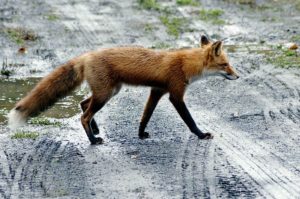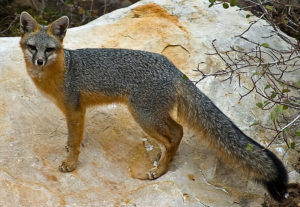A few weeks ago Deborah and I stepped out on the deck around 8 pm to give Izzy a chance to “do her business” (such a sweet way to phrase it!). The sun had dropped below the tops of the trees, but there was still good light and clear visibility. The deer were scattered across the field, both of this year’s fawns were over by the apple tree chewing freshly fallen green apples and paying us little attention, and Izzy was sniffing around in her fenced in yard.
But then, Deborah saw some movement along the north edge of the field in the brushy thicket on the tree line. An animal was moving quickly to the west, away from us, but he was very distinctive: reddish brown in color, pointed ears, long muzzle, low slung carriage, and a long bushy tail with a white tip. It was a red fox (Vulpes vulpes).
We watched the fox vanish and then re-appear several times as it moved in and out of the tangles of raspberry and blackberry along the field edge. Then he entered the woods at the bottom of the field and was gone.
How did I know that this was a red fox and not a coyote? The animal’s size, color, and tail were all distinctive, but it was the reaction of the deer that confirmed it all. They paid no attention at all to the fox! To them, he must have been a very familiar component of our field and woods ecosystem (even though neither Deborah nor I have ever seen him before!). They knew that a fox posed no threat to them or their well grown fawns. A coyote, though, would be a great cause for alarm (especially for the fawns)!
The red fox is the ultimate generalist. It can eat almost any type of food (from fruits and earthworms, to garbage and carrion, to chickens and garden vegetables) and is even able to actively hunt rabbits and mice. It can thrive in both wild and human-dominated habitats and is found all across the Northern Hemisphere (North America, Europe, and Asia).
The red fox is called the “cat-like” canine. Although it is quite obviously a member of the dog and wolf family with overwhelming anatomical and behavior similarities to other canids, the red fox’s long, very thin canine teeth and its ventrally slit pupils with their pronounced tapeta lucida are obvious cat-like features. These anatomical “cat-like” characteristics are accentuated by the fox’s slinking and pouncing, “mousing” hunting behaviors, and also by its use of its sensitive front paws to capture and pin prey. Also, the red fox’s sustained, piercing bite to effect a prey kill (as compared to the bite and shake killing method of most other canids) are remarkably cat-like in nature.
The eye features unquestionably have evolved because of the nocturnal hunting behaviors of the fox. The teeth, use of paws to catch and pin prey and specific stalking behaviors are evolutionary strategies that are most efficient for the capture of small prey items like mice and voles. The “cat-like’ nature of the red fox, then, is logically due to the similarity of prey items and activity times that many cats and the red foxes share. One other cat-like behavior, though, that is not so easily explained is the lateral threat stance used by foxes in aggressive displays (standing sideways, back arched, fur erect etc.). This very classic “cat pose” seems out of place in the behavioral display of a canine!
There are four possible canids that any of us might see running through our yards and fields: dogs, red foxes, gray foxes, and coyotes (there are, sadly, no wolves in Western Pennsylvania!). Let’s think first about distinguishing our very familiar domesticated species from the cluster of these three wild animals.
Dogs even on a quick glance look quite different from foxes and coyotes. Dogs have an immense range of sizes (from 5 to 150 pounds!) and a great variation in coat colors and hair lengths. Most dog breeds have floppy ears, short muzzles, and steep foreheads (to make room for their large, domesticated brains!). They also typically hold their tails in an upward curve when they are running. Dogs also look less leggy and usually less lean than their wild counterparts: they have deeper chests and slightly shorter upper leg bones than their wild relatives (as you can see in the picture to the left of my old friend Kozmo!).
We can discuss red foxes and gray foxes together even though they are quite different animals. In fact, they are in completely different genera (the red fox is Vulpes vulpes, and the gray fox is Urocyon cinereoargenteus). They are, however, both small (8 to 15 pounds), pointy muzzled, flat foreheaded, pointy eared canids with long, bushy tails. Red foxes are usually, as their name implies, a reddish-brown color but individuals may be found in a wide range of browns and even grays. Most red foxes, though, will have black legs (their “stockings”) and a white tip on the end of their tails.
Gray foxes, as their name implies, are usually gray in color (especially on their backs), but they may have a great deal of reddish-brown hair on their sides. Their back coats usually have a dabbled pattern of gray and black (this color pattern makes the gray foxes I have seen in the wild seem to shimmer as they move along!). Gray foxes also have a black stripe down the middle of their backs that extends on down to the tip of their tails. They lack the black leg stockings and the white tail tip of the red fox. You might also see a gray fox up in a tree! Although red foxes and coyotes are known to climb trees at need, the gray fox with its curved claws is very well adapted to and very accomplished at tree climbing! Finally, red foxes, as I mentioned above, are much more likely to be found around people. The gray fox is a more specialized species of forest habitats.
The coyote (Canis latrans (or here in the East, C. latrans x C. lycaon (eastern coyotes are hybrids of the western coyote and the eastern (gray) wolf)) is much larger than either of the foxes but right in the middle of the size range of domesticated dogs (eastern coyotes weigh between 30 and 45 pounds). The eastern coyote is larger than the western sub-species due to the genetic influence of the eastern wolf. Coyotes have pointed ears, a long, pointy muzzle, a flattened forehead, and a shorter, though often bushy (usually black-tipped) tail that it carries below its back when it runs. Coyotes have a lean, leggy look due their shallower chest and longer upper leg bones (as compared to those of a domesticated dog). As I have written in previous blogs, the eastern coyote is a seldom seen but nearly ubiquitous species in almost any wild, rural, suburban or urban habitat throughout the eastern United States. My neighbors just across the street have seen coyotes running in the shadows across their open yards, and I have seen film of coyotes in suburban Chicago quietly watching people moving from their cars to their front doors totally oblivious of their presence.
So, there are dog-like animals out there running around in the night! They are alert and watchful and mostly want to be left alone! Sounds like a good deal to me!






Jim and I have been lucky to have a lovely family of 4 gray fox who have a burrow just behind our house on the river hillside. We have had fox live near us before, but only in times, alas, that we had no dogs sharing our lives. Our great pal, Bobby, the little Cairn terrier with the huge heart, passed from our lives in May. His loss meant the gain of gray fox. We have seen red fox in the past but not this summer. There must be more family units of gray in our area because a number of neighbors have commented seeing as many as 5 hanging out together. I put leftovers and fruit on a stump and watch for them. Most days we are rewarded with at least one sighting. So nice.